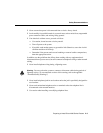
Preparing to Install Cisco 4000 Series Routers 2-9
Inspecting the System
In addition, you might need the following additional external equipment:
• Data service unit (DSU) to connect each serial port to an external network.
• To connect a serial port to a T1 network, you need a T1 channel service unit/data service
unit (CSU/DSU) that converts the High-Level Data Link Control (HDLC) synchronous
serial data stream into a T1 data stream with the correct framing and ones density.
(Some telephone systems require a minimum number of one bit per time unit in a data
stream, called ones density.) Several T1 CSU/DSU devices are available as additional
equipment, and most provide either a V.35, EIA/TIA-449, or EIA-530 electrical
interface.
• Ethernet transceiver.
• Network Terminator 1 (NT1) for BRI connections in North America.
• Before installing a G.703/G.704 network processor module, ensure that you have one
of the following adapter cables:
— 75-ohm, unbalanced adapter cable (CAB-E1-BNC-3M)
— 120-ohm, balanced adapter cable (CAB-E1-TWINAX-3M)
Inspecting the System
Before unpacking the system, make certain that you are ready to install it. If the final
installation site is not ready, keep the chassis in its shipping container to prevent accidental
damage. After determining where you want the system installed, proceed with the
unpacking.
The router, cables, publications, CD, and any optional equipment you ordered might be
shipped in more than one container. When you unpack each shipping container, check the
packing list to ensure that you received all of the following items:
• Router
• 6-foot (1.8-meter) power cord
• Bag of rubber feet for desktop mounting
• Optional equipment (which might include network connection cables)












